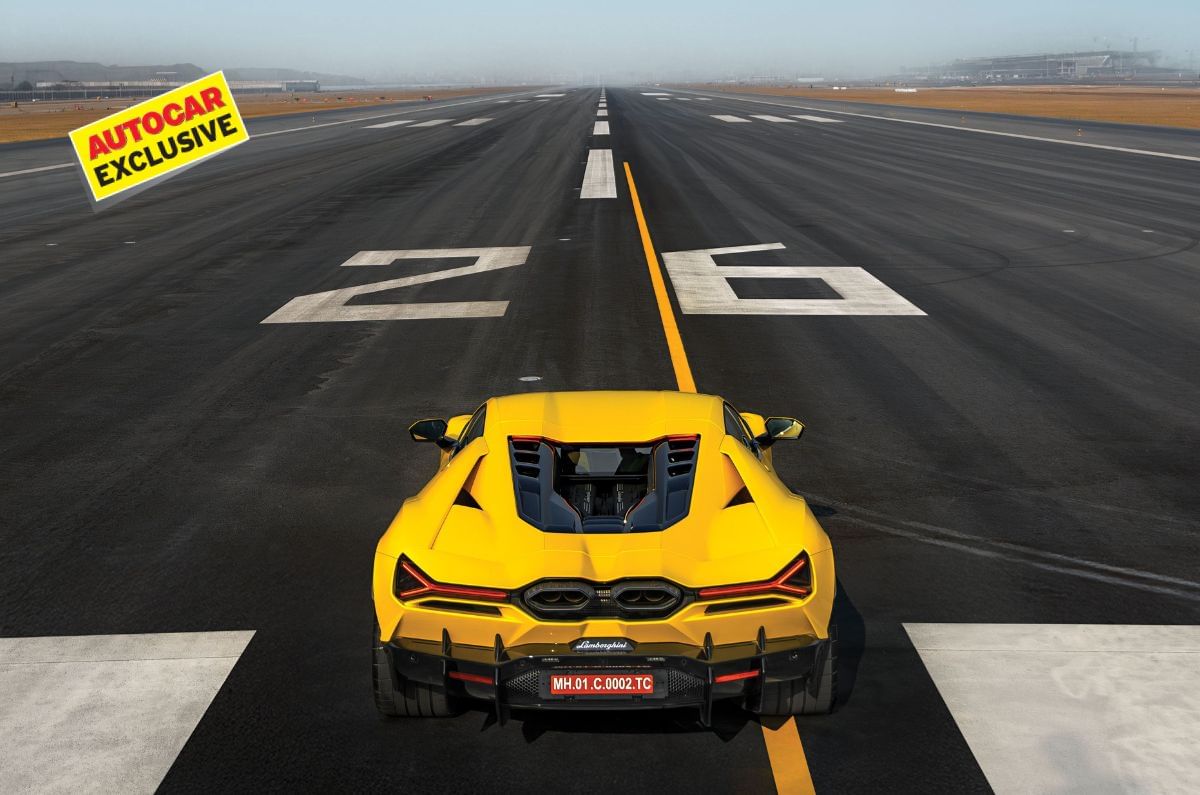
Envision a location where traveling at speeds lower than 300kph could pose a risk. A magnificent stretch of asphalt where speed is not merely a choice – it’s a necessity. This isn’t just any road; it’s a 3.7km-long runway where wide-body jets routinely land at velocities between 240kph and 290kph. Slowing down could result in plummeting from the sky.
Welcome to the Navi Mumbai International Airport, a colossal infrastructure endeavor that has taken decades to materialize and is now on the verge of completion. And what better way to inaugurate this remarkable new stretch of flawless asphalt than with the sensational Lamborghini Revuelto.

Why the Revuelto, you ask? Simply because it holds the title for the fastest car available in India, embodying the essence of future innovation—much like the Navi Mumbai airport itself.
Additionally, Lamborghini has drawn inspiration from fighter jets, making this striking machine an appropriate choice for this lofty journey.
Lambo’s flagship hypercar features an all-wheel-drive, 1,015hp, plug-in hybrid V12 engine that merges exceptional performance with state-of-the-art technology. It stands as the most powerful Lamborghini manufactured to date, and on a runway capable of accommodating the world’s largest passenger aircraft, the Airbus A380, this raging bull finally has the room it deserves—a space where it can truly unleash its power.

Equipped with a 6.5-litre V12 engine, enhanced by three electric motors—two located at the front for torque vectoring and one housed in the transmission—this car maximizes traction. It can propel the vehicle from 0-100kph in merely 2.5 seconds and reach 200kph in just 7 seconds. However, today’s ambitions soar even higher than just these numbers.
I cautiously ‘taxi’ to the runway’s edge in EV mode, experiencing the surreal silence of the Revuelto’s electric drive. I am now in a realm where horsepower has wings, where velocity is gauged in knots, and where lift supersedes grip. Typically reserved for fighter jets and flight crews, this exceptional space is completely at my disposal. I am not just another passenger crammed into a commercial seat; instead, I am secured within a carbon-fiber bucket, cherishing this unprecedented opportunity.

The runway lights twinkle in the distance, distorted by the rising heat haze, specially illuminated for my experience, replicating the sensation of a pilot’s journey. The red, green, white, and amber lights convey a coded language to aviators: guiding their path as they land and take off. The tall amber lights lining the edges signify the runway boundary; each of these costs an astonishing Rs 90,000. “You hit them, you pay,” warns Prabhat Mahapatra, COO of Navi Mumbai International Airport Ltd (NMIAL). The financial dynamics of aviation operate on a different plane altogether—here, Rs 12 crore for a Revuelto seems quite reasonable in comparison.

Safety is of utmost importance at Navi Mumbai airport—no compromises are tolerated. Every aspect here meets global standards, from the precision of corresponding taxiways to the elegant finishes of terminals. It is world-class in every respect, so exceptional that passengers and pilots alike could easily believe they’ve arrived in Singapore or Frankfurt. However, the journey to this airport reveals a contrasting tale. Outside the airport gates, the roads appear bumpy, with uneven paving and posts that occasionally confuse drivers. Fortunately, plans for improved roads and more straightforward access are underway. Remarkably, we reached the airport’s gates in just 35 minutes from our Autocar office in Chinchpokli!
Lamborghini Revuelto vs Runway
“Autocar 25, you’re cleared for take-off.” Those words crackle across the intercom, signifying the start of my ‘pre-flight’ preparations. Tyre pressures are satisfactory, the Drive mode is set to Corsa, and the EV settings are primed for peak performance. Launch Control? That’s a firm no, as the NMIAL authorities aim to avoid rubber marks on the runway! I nudge the accelerator, slowly getting the Revuelto rolling before flooring it. We are launched forward, as if propelled by a catapult. This is not merely a drive; this is an exhilarating lift-off!

240, 270, 300—the numbers race past. The car remains perfectly aligned, with the active rear wing adjusting for maximum downforce—quite the reverse of a plane’s wings, which are specifically crafted for lift.
The digital speedometer soars to 355kph before the soft limiter engages, as though it’s saying, “Alright, enough for today.” Given the calibration errors, the actual top speed is effectively 350kph. This limitation exists not because the Revuelto lacks the potential for increased velocity, but due to constraints posed by the tires at elevated speeds. The sheer ferocity with which the Revuelto accelerates to its peak velocity indicates that, without restraint, it could indeed reach even higher speeds—perhaps even 400kph. There’s still one gear remaining! The Revuelto peaks in seventh gear instead of eighth, as the eighth is primarily for cruising rather than high-performance acceleration. Seventh gear, with its shorter ratio, equips the V12 engine with the torque and rpm necessary to propel the car to its ultimate speed.

The Revuelto achieves its top speed in under 2km, leaving me with 1.7km to decelerate. I could have utilized an additional kilometer for acceleration if necessary, thanks to the Revuelto’s carbon ceramic brakes—each disc larger than a dinner plate—that safely slow it down from exhilarating speeds, similar to an aircraft deploying reverse thrust.
The melodious roar of the V12 engine captures the essence of what a naturally aspirated engine can be, even amidst this hybrid age. The 6.5-litre V12 howls up to 9,500rpm, its tone escalating with each rev, becoming increasingly frenzied as it approaches the redline. The sound is not merely loud; it’s operatic! Coupled with the lightning-fast shifts of the new 8-speed DCT, the Revuelto’s acceleration transforms into something not just relentless, but deliciously brutal.
On this wide, 45-metre runway, where there’s no congestion, no trepidation, and only a direct path ahead, the Revuelto not only feels fast—it feels… right. This is the type of speed destined for the skies.
This is appropriate, as this is no ordinary stretch of asphalt. The runway adheres to Code F regulations, constructed to accommodate aircraft such as the Boeing 777 and the massive Airbus A380, which can have maximum takeoff weights of around 560 tonnes—over 400 times heavier than the Revuelto, which today hovers gracefully like a feathered dart on an Olympic javelin field.
The construction of this airport demanded leveling an entire hill, rerouting rivers, and relocating high-tension power lines. It represents an infrastructure project on a scale beyond imagination. Today, prior to the first commercial flight’s arrival, we’re experiencing a maiden run of sorts—not by air, but using four tires and the symphony of a V12.

What impresses the most goes beyond mere speed and the adrenaline rush of acceleration. It’s the tranquility. The runway is impeccably paved, spacious, and free of disruptions, allowing the Revuelto to feel at ease. It glides, howls, and carves through the air like a jet. In those fleeting moments, you forget it’s a car—you forget you’re still on Earth.
Eventually, this runway will feature boarding gates, taxiways, and signage directing destinations. When I eventually board my first commercial flight from here, I’ll take a moment to smile—because my journey began here, not in the skies, but on the ground—in a Revuelto.
Q&A with Prabhat Mahapatra, COO, NMIL

You’ve reported speeds of 355kph on this runway; doesn’t that align more with typical aircraft landing and takeoff speeds?
During takeoff, speeds reach approximately 300kph, while landings average around 240-290kph, varying according to the aircraft model.
Can you tell us what was involved in constructing this state-of-the-art runway?
This runway was engineered for Code F aircraft like the Airbus A380, designed based on the anticipated number of annual landings. Much of the terrain was hilly, resulting in an exceptionally robust foundation—truly best-in-class. The runway features an Instrument Landing System Category II, enabling landings in low visibility conditions of up to 350 meters. It boasts a width of 45 metres, flanked with 15-metre shoulders on either side, and stretches 3,700 metres in total, accommodating all types of aircraft.
What can you tell us about the planned second runway and its operational benefits?
 The control tower, the nerve center of airport operations, is nearing its completion.
The control tower, the nerve center of airport operations, is nearing its completion.
The challenge at CSMIA (Chhatrapati Shivaji Maharaj International Airport) lies not in terminal capacity, but rather in runway capacity. The two existing runways intersect, allowing only one to be utilized at any given moment. However, with NMIAL, the congestion in Mumbai’s air traffic will be effectively alleviated. The North Runway is projected to be in service by 2029. Collectively, there will be three parallel runways functioning across the Mumbai-Navi Mumbai system, significantly enhancing capacity. By operating both runways simultaneously, we aim to allow for around 90 to 100 movements per hour.
In what ways will this airport surpass CSMIA, the existing Sahar airport?
Land constraints in Mumbai forced the CSMIA terminal building into a curved structure. In contrast, the terminal in Navi Mumbai is linear, optimizing the passenger flow with more travelators, ensuring no traveler walks more than 400 meters. Alongside the immigration counters, significant investments are being channeled into digitization, introducing a Fast Track Trusted Traveller program that will allow check-in and check-out without any manual interactions. We also plan to integrate CTX baggage scanning machines in the future.
Digi Yatra will be operational from day one, supported by a team of data scientists analyzing numerous data points to enhance airport efficiency. Our commitment lies in leveraging technology to provide an unmatched passenger experience, maximizing digitization, and emphasizing sustainability.

Our emphasis on sustainability is equally critical. From day one of operations, the use of electric vehicles will be mandatory, and solar power installations are forthcoming. Ultimately, this airport aims to manage an annual passenger traffic of 90 million.
Can you elaborate on the critical regulations involved in establishing an airport?
In India, our major regulators concerning safety and security are the Directorate General of Civil Aviation and the Bureau of Civil Aviation Security, respectively. Adhering strictly to all regulations is paramount to ensuring the safety and security of passengers. As a part of the Adani Group, we adhere unyieldingly to these standards.





